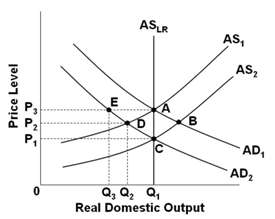When every good or service is produced up to the point where the last unit provides ________, allocative efficiency occurs
A) a marginal benefit to society equal to the marginal cost of producing it
B) a marginal benefit to society greater than the marginal cost of producing it
C) a marginal benefit to society less than the marginal cost of producing it
D) a marginal benefit to society equal to zero
Answer: A
You might also like to view...
If a firm produces 20 units of output and incurs a total cost of $1,000 and a variable cost is $700, calculate the firm's average fixed cost of production if it expands output to 25 units
A) $300 B) $15 C) $12 D) It is impossible to determine without additional information.
For the 1952-2014 period in the United States, output per worker hour
A. showed the largest increase during the 1980s. B. fluctuated around an upward trend. C. increased at a constant rate. D. decreased during the 1960s.
Refer to the information provided in Table 20.4 below to answer the question(s) that follow. Table 20.4GermanyChileBeerWineBeerWine(cases)(cases)(cases)(cases)75030 060152412453018 24304512 361560 6 48075 0 60 Refer to Table 20.4. Chile has
A. an absolute advantage and a comparative advantage in beer production. B. an absolute advantage and a comparative advantage in wine production. C. a comparative advantage in wine production. D. neither a comparative advantage in wine production nor in beer production.
Refer to the graph below. Assume that the economy is in initial equilibrium where AD1 intersects AS1. If there is an unanticipated decrease in aggregate demand to AD2, then in the view of new classical economics the economy will:

A. Self-correct through a shift in AS, which brings output back to Q1
B. Self-correct through a shift in AD, which brings output back to Q1
C. Need the government to implement expansionary policy in order to bring output back to Q1
D. Need the government to implement contractionary policy in order to bring output back to Q1